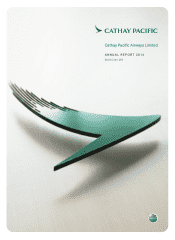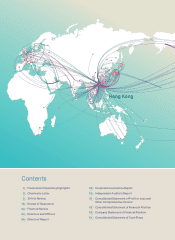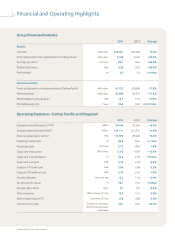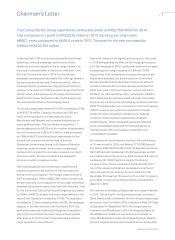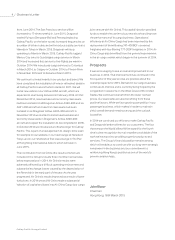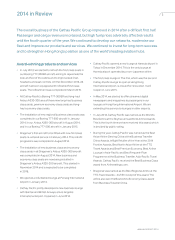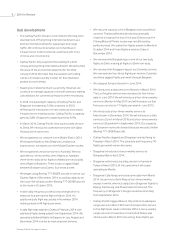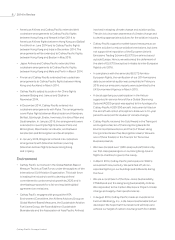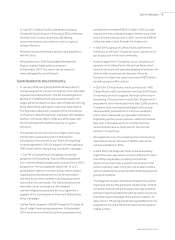Cathay Pacific 2014 Annual Report Download - page 5
Download and view the complete annual report
Please find page 5 of the 2014 Cathay Pacific annual report below. You can navigate through the pages in the report by either clicking on the pages listed below, or by using the keyword search tool below to find specific information within the annual report.
ANNUAL REPORT 2014
3
Chairman’s Letter
The Cathay Pacific Group reported an attributable profit of HK$3,150 million for 2014.
This compares to a profit of HK$2,620 million in 2013. Earnings per share were
HK80.1 cents compared to HK66.6 cents in 2013. Turnover for the year increased by
5.5% to HK$105,991 million.
In the first half of 2014 our business was affected by high
fuel prices, reduced passenger yield and continued
weakness and over-capacity in the air cargo market. Our
business is normally better in the second half than in the
first half. This was the case in 2014. For the full year,
passenger demand was reasonably firm, with high demand
during the peak summer and Christmas periods. After a
prolonged period of weakness, cargo demand started to
improve in the summer of 2014 and was strong in the fourth
quarter, which is the peak period for cargo. Our business
benefited from lower fuel prices in the fourth quarter, but
this was partially offset by fuel hedging losses.
The Group’s passenger revenue for 2014 increased by 5.4%
to HK$75,734 million. Capacity increased by 5.9% as a
result of the introduction of new routes (to Doha,
Manchester and Newark) and increased frequencies on
some existing routes. The load factor increased by 1.1
percentage points to 83.3% and the number of passengers
carried increased by 5.5% to 31.6 million. Yield decreased
by 1.8% to HK67.3 cents despite an improvement in the
second half compared to the first half of the year.
Passenger demand was strong in all classes of travel on
long-haul routes. However, the increase in passenger
numbers did not match the increase in capacity on North
American routes. Strong competition put downward
pressure on yield on regional routes.
After a prolonged period of weakness, cargo demand
started to improve in the summer of 2014 and was very
strong in the fourth quarter. The Group’s cargo revenue in
2014 increased by 7.3% to HK$25,400 million compared to
the previous year. Over-capacity in the air cargo market put
downward pressure on rates in the first half of the year. Yield
for the full year for Cathay Pacific and Dragonair decreased
by 5.6% to HK$2.19, despite improved cargo demand in the
second half. Capacity increased by 10.4%. The load factor
increased by 2.5 percentage points to 64.3%. We managed
capacity in line with demand in the first half of 2014, but
were able to operate an almost full freighter schedule for
most of the second half. Our new cargo terminal worked
effectively in its first full year of operation and made our
cargo operations more efficient.
Fuel is the Group’s most significant cost and our fuel costs
in 2014 (disregarding the effect of fuel hedging) increased
by 0.7% compared to 2013, significantly below the increase
in passenger and cargo capacity of 5.9% and 10.4%
respectively. Fuel consumption increased because more
flights were operated, but the introduction of more fuel-
efficient aircraft and the retirement of less fuel-efficient
aircraft moderated the increase. We also benefited from
lower fuel costs in the fourth quarter. Fuel accounted for
39.2% of our total operating costs, compared to 39.0% in
2013. Managing the risk associated with high and volatile
fuel prices is a priority. Our fuel hedging contracts extend to
2018. The sharp reduction in fuel prices in the fourth quarter
of 2014 caused a very welcome net benefit to overall
profits. However, it resulted in losses on our hedging
contracts. It also resulted in significant unrealised
hedging losses. These unrealised losses are reflected
in the consolidated statement of financial position at
31st December 2014 and caused a reduction in our
consolidated net assets.
We continue to invest heavily in our fleet. We took delivery
of 16 new aircraft in 2014: nine Boeing 777-300ER aircraft,
five Airbus A330-300 aircraft and (for Dragonair) two Airbus
A321-200 aircraft. Six Boeing 747-400 passenger aircraft
were retired during the period. In 2013, we agreed to sell our
six Boeing 747-400F freighters back to The Boeing
Company. One of them was delivered in November 2014.
Two of the remaining freighters are parked and all five of
them will have left the fleet by the end of 2016. At 31st
December 2014 we had 79 new aircraft on order for delivery
up to 2024. A total of nine new aircraft are scheduled for
delivery in 2015.
We continue to develop our passenger and cargo networks.
In 2014, Cathay Pacific introduced passenger services to
Doha, Manchester and Newark. We will introduce passenger
services to Zurich in March 2015, to Boston in May 2015 and
to Dusseldorf in September 2015. We reorganised our
network in the Middle East in 2014. We stopped flights to
Abu Dhabi and Jeddah but improved our schedules on
other Middle Eastern routes. We stopped flying to Karachi.
The Los Angeles service was increased to four-times-daily

